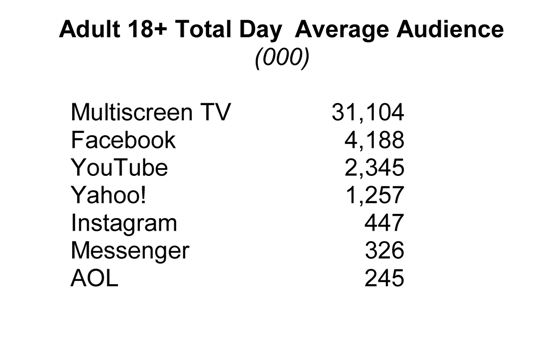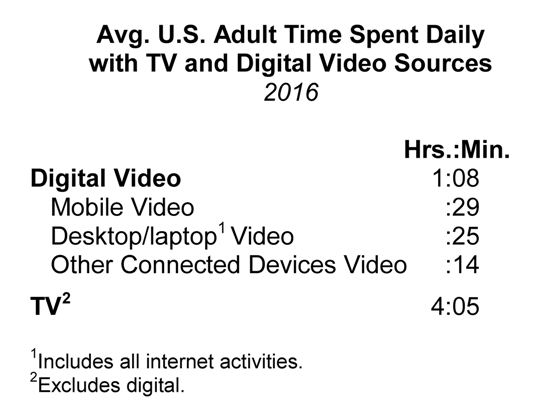
Media Matters goes beyond simply reporting on current trends and hot topics to get to the heart of media, advertising and marketing issues with insightful analyses and critiques that help create a perspective on industry buzz throughout the year. It's a must-read supplement to our research annuals.
Sign up now to subscribe or access the Archives
A recent Video Advertising Bureau (VAB) report, New "Fronting" 2016: Applying "Meaningful" Comparable Metrics To Ad Tech's "Big" Data Claims During The 2016 NewFronts, tries to quantify a point that we've consistently made for quite some time: despite inroads by digital media, TV remains the biggest audience draw, even among coveted Millennials.
The report was produced as a response to huge audience claims made by digital platforms as part of their "NewFront" presentations. As we all know, hype is part of any upfront presentation, be it digital or traditional media, however, as the VAB rightly points out, the stats cited by these digital platforms aren't comparable to those made by traditional TV, and are, as such, potentially misleading.
The VAB's formula follows a two-step process. In the first step, the unique audience is multiplied by the average minutes viewed per visitor to produce the total minutes viewed. The "total minutes viewed" is then divided by the total minutes of the time period being evaluated to produce the "average audience. For this particular report, the VAB used a 24-hour time frame for digital platforms and networks/channels, and the program run time for specific programs. The VAB used March 2016 comScore Media Metrix and Nielsen (TV Live + same day) data to produce its findings.
Using this "average audience" formula, TV (both traditional and online) comes out far ahead of digital platforms:

Similar proportions prevail for "average audience" among 18-34s, according to this report. These results dovetail with tonnage estimates that we presented in both TV Dimensions and Media Matters earlier this year.
To drive its point home, the VAB concludes its report with a comparison of how digital ad platforms stand up against individual TV shows. Based on the examples given, one might conclude that even the top digital platforms (Facebook and YouTube) would be cancelled due to low ratings, if they were network TV shows (the NBC show Heartbeat, and ABC's The Muppets had similar average audience ratings and were both cancelled).
Of course this is part of the angle—obviously the VAB wants to present TV in the best possible light. The association—formerly known as the Cabletelevision Advertising Bureau—is a consortium of broadcast and cable channels whose goal is to promote television. Hence, TV overall "beats" Facebook. If the data were examined on a network/channel basis, the results wouldn't be so impressive.
Aside from how the VAB presents its data, the fact of the matter is that "video," regardless of the platform on which it is delivered, is an effective environment for the delivery of ad messages. With TV still in the lead in delivery of audiences to this content, it remains a force to be reckoned with.
Despite all of the chatter about digital, TV remains king of viewing. U.S. adults spend an average of 4:05 hours a day with TV and 1:08 hours with digital video devices (including mobile, desktop/laptop, and game consoles and connected TVs), according to new numbers released by eMarketer. Nondigital TV continues its reign even as the use of digital video sources grows, far exceeding the time spent with any individual one of these components.
Emarketer predicts that as digital media increases, the overall use of non-digital TV will decrease; however, the former will remain a small portion of the overall time spent. This correlates with our findings in Intermedia Dimensions 2016, which show that in 2015, adult daily live/delayed TV viewing by all adults witnessed the slightest decline while digital usage continued to grow. Overall, however, TV is by far the preferred choice when it comes to video viewing. For our full report on time spent with all media, including trending and demographic breakdowns, check out Intermedia Dimensions 2016.
